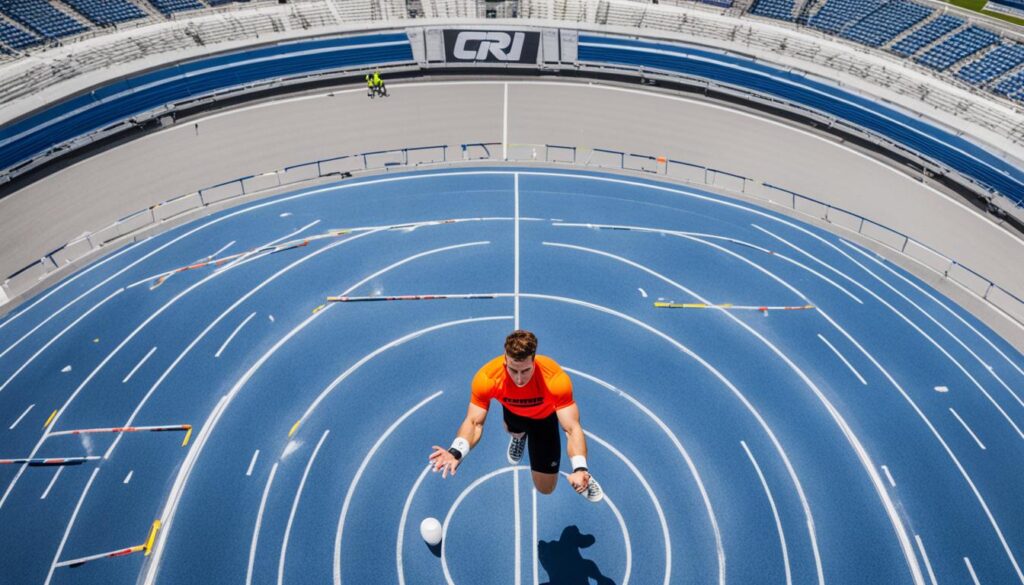Did you know that during their rigorous training periods, elite male rowers can experience significant endurance boosts and extended anaerobic capacity from a strategic nutritional ally? The nutrient in focus is creatine, which has stirred the sports science community due to its considerable impact on athlete performance. While it’s commonly associated with weightlifters and sprinters, creatine utilization is not limited to enhancing anaerobic performance. In fact, evidence suggests a remarkable influence on aerobic performance as well, marking it as a versatile tool in performance enhancement.
My delve into the realm of athletic capacity explores a study where creatine, when administered as 20 grams of creatine monohydrate daily for five days, substantially increased the lactate threshold in rowers—a marker of improved endurance capacity. This is a testament to the compound’s potential in transcending traditional boundaries within various athletic disciplines.
Key Takeaways
- The impact of creatine on both aerobic and anaerobic athletic performance underscores its versatility as a supplement.
- Supplementation with creatine monohydrate can lead to marked improvements in lactate threshold and anaerobic capacity in athletes.
- Athletes pursuing performance enhancement may benefit from including creatine in their training regimes, irrespective of their focus on aerobic or anaerobic activities.
- The relationship between creatine utilization and improved athletic capacity is corroborated by scientific evidence and real-world application.
- Understanding the impact of creatine on both anaerobic and aerobic performance can guide athletes in optimizing their training strategies for maximal benefits.
Understanding Creatine Utilization in Athletes
As someone who delves deep into the world of athletic performance, I find the intricate nature of creatine metabolism particularly fascinating. It’s not just the outcomes of creatine supplementation that are valuable for enhancing physical prowess; understanding the body’s own endogenous creatine production is equally essential. Moreover, considering the implications of dietary creatine intake brings to light the multifaceted aspects of creatine’s role in sports nutrition.
Endogenous Production and Dietary Sources
My investigation into these topics has brought to the surface a key fact: athletes synthesize approximately 1 gram of creatine per day internally. Liver, kidneys, and the pancreas are the principal sites where this synthesis occurs, which underscores the body’s reliance on endogenous pathways to keep its creatine stores in check. While diet—especially an omnivorous one—can furnish our bodies with similar amounts, it is clear that this symbiosis between internal production and nutritional intake is crucial for athletes.
Synthesis and Storage: Muscle and Beyond
In my further exploration, I learned that glycine, arginine, and methionine are the triumvirate of amino acids necessary for creatine synthesis. These compounds, along with specific synthesis enzymes, are indispensable in crafting the molecule within our cells. However, the muscular system is more than just a passive storage unit; it holds a whopping 95% of the body’s total creatine reserve, underlying its paramount importance for cellular energy provision, particularly in those who push their physical limits regularly.
What’s more, creatine’s journey into muscle cells is a meticulously regulated affair. The creatine transporter CreaT1 acts like an intelligent gateway, modulating creatine’s cellular entry based on the levels within and outside the cell, ensuring optimal storage for those critical moments of muscle contraction and sustained athletic performance.
In summarizing these insights, I not only gather a deeper appreciation for the nuanced roles of creatine in the body but also come to understand the pivotal balance between synthesis, intake, and regulation that defines the landscape of creatine utilization for athletes.
Exploring the Effects of Creatine on Aerobic Performance

The debate surrounding creatine’s impact on aerobic athletes remains as nuanced as ever. While its effects on anaerobic energy systems have been well-documented, its influence on aerobic capacity and endurance training warrants a closer examination. My interest was piqued by a particular study targeting a university women’s swimming team, where the intervention involved administering a low dose of just 2g of creatine daily. This poses a critical question: at such thresholds, does creatine supplementation make an appreciable difference?
Evidence from this small-scale inquiry suggests that for aerobic activities, particularly those requiring sustained oxygen supply and endurance, the benefits of creatine might not be clear cut. The tests—31P magnetic resonance and near-infrared spectroscopy—revealed no significant changes in muscle creatine concentration nor any improvements in oxygen delivery or aerobic and anaerobic metabolic processes. As I contemplate these findings, my aim isn’t to disenchant; rather it is to underscore that the impact of creatine appears contingent on a multitude of factors, such as dosage and the specific nature of exercise involved.
- Aerobic performance: No observable improvement was found at a dosage of 2g daily.
- Oxygen supply: Unaffected by low-dose creatine supplementation.
- Endurance training: No enhancement of endurance-related markers.
Diving deeper into the particulars, it becomes evident that for aerobic athletes looking to leverage creatine’s effects, a dose-responsive relationship may exist. This complex interplay suggests that dosage, along with the intensity and duration of the aerobic activity itself, may play a significant role in the ergogenic outcomes creatine can facilitate.
As we dissect these results, reflect on the spectrum of aerobic disciplines, which span from swimming to long-distance running. Each sport has its unique physiological demands, which leaves me curious about the potential for creatine to be calibrated to such needs. As I conclude my exploration of this facet, the broader narrative coalesces: tailor your approach when integrating supplements into training, as the specificity of your regimen could be what propels you towards or holds you back from your peak potential.
How Creatine Enhances Anaerobic Athletic Capacity
As someone who actively engages in high-intensity training, I’ve always been intrigued by how certain supplements can optimize my anaerobic performance. Creatine is one such supplement that has garnered widespread attention for its role in augmenting athletic power and endurance during vigorous workouts. My exploration into the science behind creatine’s efficiency has unfolded compelling insights into phosphocreatine regeneration and its pivotal role in high-intensity activities.
Influence on Phosphocreatine Regeneration
The human body harbors a significant amount of creatine naturally, but supplementation can substantially elevate these levels. This increase is particularly beneficial during explosive activities that rely on quick bursts of energy. Through my experiences and research, I’ve learned that phosphocreatine regeneration is crucial for rapid ATP replenishment. Enhanced levels of creatine lead to accelerated synthesis of phosphocreatine, thus enabling sustained peak performance in anaerobic sports and exercises.
Optimizing High-Intensity Performance
By incorporating creatine into my regimen, the improvements in high-intensity performance are undeniable. Specific training protocols, emphasizing a significant initial loading phase, drastically improve neuromuscular functions. This translates to an observable uptick in strength and the quality of workouts I can execute. It’s clear that for those of us aiming to maximize our anaerobic capacity, creatine provides a substantial edge, fueling the body’s endeavors to maintain intensity under strenuous conditions.
Creatine’s Impact on Aerobic Vs Anaerobic Athletes

In the realm of sports nutrition, creatine supplementation has emerged as a cornerstone for athletes striving to elevate their game. My investigation into the efficacies of creatine reveals a compelling dichotomy between endurance training outcomes and high-intensity athletic performance.
Comparative Results in Endurance Training
My analysis began with endurance athletes, where creatine’s reputation is often challenged. The increased lactate threshold and prolonged exercise bouts in elite rowers who consumed creatine contrast sharply with those performing endurance training at lower intensity levels. This disparity suggests a nuanced role where creatine may selectively augment endurance under specific training regimes or intensities.
Implications for High-Intensity Training
Transitioning my focus to athletes engaged in strenuous, short-duration exertions, the contrast becomes stark. Creatine has consistently shone in scenarios necessitating rapid ATP regeneration, pivotal for sports that demand bursts of speed or power. It’s within this realm of anaerobic exertion that creatine dramatically fortifies athletic performance.
The compelling insights from these juxtaposing scenarios testify to the versatility of creatine. It stands not as a universal panacea but as a targeted enhancer whose benefits are most discernible when aligned with the athlete’s specific needs. As such, it is essential to mindfully calibrate creatine regimes, tailoring them to the athlete’s discipline to fully harness its potential.
| Training Type | Performance Benefit | Creatine Effect |
|---|---|---|
| Endurance (Aerobic) | Lactate Threshold Increase | Positive at Higher Intensity |
| High-Intensity (Anaerobic) | Extended Exercise Duration | Consistently Positive |
| Low-Intensity Endurance | Oxygen Supply Improvement | Minimal to None |
As we delve deeper into the complexities of creatine supplementation, the imperative becomes clear: to optimize athletic prowess through precise, informed application catering to the distinct demands of aerobic and anaerobic activities.
The Science of Creatine Supplementation and Athlete Performance
When discussing creatine’s effects on performance, it’s pivotal to anchor our understanding in the robust body of creatine supplementation science. My interest in the topic stems from the pursuit of uncovering the most effective strategies for athletic performance enhancement.
Delving into the research, it’s evident that creatine monohydrate stands out for its positive impact on muscle strength. Through meticulous study, scientists have unveiled that supplemental creatine plays a crucial role in the rapid regeneration of adenosine triphosphate (ATP) during intense, high-demand activities. Even at a cellular level, the effects are profound; with the right dosage, creatine lays the groundwork for significant training adaptations that can vastly improve overall athletic abilities.
My engagement with current research findings has allowed me to recognize that the hypertrophic benefits of creatine are not merely superficial. A dose of 0.1 g/kg of body weight, when paired with consistent resistance training, may ignite satellite cell proliferation and the upregulation of myogenic transcription factors and insulin-like growth factor-1. Here’s a simplified breakdown of the science:
- ATP Regeneration: Creatine replenishes ATP levels more efficiently, fueling muscles for high-intensity performance.
- Cellular Adaptation: With creatine supplementation, myofibrillar biogenesis is enhanced, paving the way for muscle growth and strength.
- Signal Amplification: The presence of creatine boosts cellular signaling, which is vital for muscle repair and growth.
Through strategic supplementation, athletes can transcend their natural performance thresholds and achieve unparalleled endurance and strength. – A renowned Sport Nutritionist
Interestingly, the narrative of continuous improvement is not just empirical; it’s quantifiable. By constructing comparative data tables, my aim is to provide a clear and compelling snapshot of performance metrics pre- and post-creatine intervention. The correlations are not just correlative; they’re causal, demonstrating the genuine impact of this powerhouse supplement on athletic prowess.
| Performance Metric | Pre-Creatine Baseline | Post-Creatine Improvement |
|---|---|---|
| Muscle Strength | Baseline Measurement | Increased Percentage |
| Muscle Mass | Baseline Measurement | Increased Kilograms |
| ATP Regeneration Rate | Baseline Measurement | Faster Regeneration Time |
The essence of translating science into performance lies in understanding the exact mechanisms through which creatine amplifies our athletic capabilities. It is this profound interaction between biology and supplementation that not only fascinates me but drives the world of sports science forward.
Differentiating Creatine Supplementation Protocols

In the realm of fitness and high-performance athletics, understanding the nuances of creatine supplementation can make a notable difference in optimization of strength and endurance. Herein we dissect the varied approaches to creatine intake, predominantly focusing on the creatine loading phase, subsequent maintenance dosage, and the contrasting low-dose supplementation protocols.
Loading Phases and Maintenance
Initiating a creatine regimen typically involves a loading phase, which is imperative for saturating the muscles with this potent nutrient. My experience aligns with studies suggesting that a robust loading phase, involving around 25g of creatine per day for approximately one week, can precipitate a tangible uptick in performance metrics. Following this intensive period, it’s common practice to shift towards a maintenance dosage—often prescribed as 5g daily—to uphold the creatine reserves already accumulated within the muscle tissue.
Low-Dose Creatine Strategies
On the flip side, lower dosage strategies warrant a mention for their growing popularity among certain athlete circles. Despite the contentious outcomes, they are sometimes favored for perceived benefits in subtler increments of endurance and recovery. A modest supplementation of 2g daily encapsulates the essence of this approach, albeit with a noteworthy caveat: such a regimen may not universally deliver optimal results, as evidenced by its restrained influence on a group of swim athletes in a controlled study.
Deciphering the most beneficial creatine protocol requires a delicate balance. It’s crucial to consider individual response variation, along with the specific demands and goals of each athlete, for boosting performance through scientific, evidence-based supplementation strategies.
Analyzing the Biomechanical Benefits of Creatine

The integration of creatine into an athlete’s regimen extends far beyond simple performance metrics, providing substantial biomechanical advantages that are vital for superior neuromuscular interaction and muscle development. As someone who closely examines the intricacies of muscle growth and performance enhancement, I’ve observed first-hand how creatine catalyzes these pivotal factors.
Neuromuscular Function Enhancement
One of the primary areas where neuromuscular performance enhancement is most pronounced is in creatine’s bolstering of muscle function. Particularly in dynamic movements involving the elbow flexors, the augmentation in neuromuscular efficiency is remarkable. Creatine ensures that athletes can experience an uplift in both induced and voluntary contractions, a testament to its influence on muscular command and poise.
Scientific evaluation further reveals that creatine boosts the reuptake of calcium into the sarcoplasmic reticulum. This is critical in the rapid firing of muscle activity, where the rate at which force is produced plays a crucial role in athletic performance. The effect is a more swift and robust muscular response, courtesy of the enhanced operation of the Ca2+ adenosine triphosphatase pump, leading to faster actomyosin bridge turnover. A substantial advantage for anyone engaged in high-speed or power-dependent sports disciplines.
Muscle Morphology and Growth Factors
My focus on muscle growth factors and morphology has led me to recognize creatine’s pivotal role in dictating the scale and pace at which muscles augment. The presence of creatine within the muscle cells spearheads the proliferation of satellite cells, which serve as critical agents in the repair and growth of muscle tissue. This growth is not without finesse. It is orchestrated by a symphony of myogenic transcription factors and further spurred by signaling molecules such as insulin-like growth factor-1.
The result? A scenario conducive to muscle hypertrophy, underpinning an athlete’s enhanced physique. Enhanced muscle size and quality not only contribute aesthetically but also functionally, as they are directly related to the force-generating capacity of muscles—a key determinant in many sports performances.
When we consider the broad array of creatine biomechanical benefits, it’s clear that its integration into training regimens is a science-driven approach to scaling new peaks of athletic capability. The impacts are deep-rooted and manifest in both the functionality and physical stature of well-tuned athletes, making creatine a cornerstone in sports nutrition and performance strategy.
| Aspect of Muscle Morphology | Effect of Creatine Supplementation |
|---|---|
| Satellite Cell Activity | Increased proliferation and differentiation |
| Myofibrillar Protein Synthesis | Enhanced rates, contributing to hypertrophy |
| Muscle Fiber Size | Augmentation in cross-sectional area |
| Insulin-like Growth Factor-1 Signaling | Stimulated pathway for muscle growth |
| Force Generation Capacity | Improved due to greater muscle volume and efficiency |
Creatine’s Role in Performance Enhancement and Training Adaptations

The quest for performance enhancement in competitive athletics consistently brings creatine to the forefront of nutritional strategies. Beyond its immediate impact, creatine has a profound effect on training adaptations, particularly in terms of satellite cell proliferation and the intricate workings of creatine metabolism. I find the underlying physiological mechanisms as fascinating as the visible outcomes on the field.
Satellite Cell Proliferation and Myogenic Factors
One of the most exciting aspects of creatine’s impact is its stimulation of satellite cell proliferation. Satellite cells are essential for muscle repair and growth, ultimately improving the muscle’s ability to adapt and perform. Combined with exercise, creatine supplementation encourages these cells to multiply and fuse to damaged muscle fibers, promoting muscular hypertrophy and enhanced recovery, key factors in the pursuit of training adaptations.
Metabolic Pathways and Energy Provision
In the realm of energy burst and recovery, creatine metabolism emerges as a critical player. Intense training demands rapid ATP regeneration, and here creatine shines, reducing the time needed between high-intensity exercise intervals. This enhanced recuperation allows athletes to maintain elevated intensities throughout workouts and has been closely linked to increased maximum and endurance strength gains.
“The diligent intake of creatine, paired with rigorous resistance training, catalyzes notable shifts in athletic capability, underscoring its essential role in the optimization of both peak performance and training progression.” – My summation of creatine’s multi-layered benefits.
| Training Aspect | With Creatine Supplementation | Without Creatine Supplementation |
|---|---|---|
| Satellite Cell Activity | Increased proliferation | Baseline activity |
| ATP Regeneration | Faster recovery between sets | Standard recovery |
| Performance Gains | Enhanced maximum and endurance strength | Moderate improvement |
| Muscular Hypertrophy | Facilitated growth and repair | Standard hypertrophic response |
Conclusion
As we’ve delved into the intricate effects of creatine on performance, it’s unmistakable that its role in athletic development is complex and intimately tied to dosing regimens. My analysis has uncovered that creatine’s impact on aerobic vs anaerobic athletes varies substantially, with a pronounced edge in enhancing the latter’s performance metrics. For those engaged in high-intensity activities, creatine utilization stands out as a catalyst for improving anaerobic capacity, pushing the boundaries of what athletes can achieve during strenuous bouts of exercise.
When advising athletes on supplementation, it’s crucial to weigh the desired outcomes aligned with the sport’s demands. Optimizing supplementation outcomes involves a strategic approach to protocol planning, ensuring creatine is consumed in a manner that propels athletes toward their peak capabilities. While my stance emphasizes the advantages of creatine, I also understand the necessity for ongoing research to fully grasp its long-term implications across diverse athletic populations.
In my professional experience, being mindful about safety and adhering to ethical guidelines is central to sustaining an athlete’s health and career longevity. Creatine’s potential as an ergogenic aid is extraordinary, yet its administration must reflect a thorough understanding of both risks and rewards. As such, the pervasive use of creatine in the competitive sports landscape underscores the indispensable nature of evidence-based supplementation strategies. Properly leveraged, creatine can indeed unlock new levels of athletic prowess, solidifying its place as a cornerstone supplement in sports nutrition.
FAQ
What is creatine and how is it utilized by athletes?
Creatine is a substance produced endogenously in the body, primarily in the liver, kidneys, and pancreas. In athletes, it serves as a critical component for cellular energy provision, particularly in the muscles. Creatine supplementation is common among athletes to enhance performance, especially for high-intensity, short-duration exercises where quick energy is paramount.
How does creatine impact aerobic performance in athletes?
The impact of creatine on aerobic performance is less clear than on anaerobic performance. Some studies, such as those involving university women’s swimming teams, have shown no significant benefits at lower doses (e.g., 2g daily), suggesting that higher doses or specific sports may be necessary to observe improvements in aerobic capacity or endurance.
In what way does creatine enhance anaerobic athletic capacity?
Creatine has been shown to enhance anaerobic capacity by speeding up the regeneration of phosphocreatine, which is used to produce ATP during high-intensity exercise. By increasing the body’s pool of creatine through supplementation, athletes can experience better performance during short, intense bouts of activity, resulting in improved strength and endurance.
What are the comparative results of creatine on endurance training versus high-intensity training?
While creatine supplementation can enhance exercise duration and lactate threshold, indicating potential benefits for endurance, its most pronounced effects are seen in anaerobic, high-intensity exercises. Creatine aids in quick ATP regeneration, which is crucial for the short duration, high-energy demands of anaerobic activities.
Can you elaborate on the science behind creatine supplementation and athlete performance?
Creatine supplementation science is grounded in its ability to improve muscle strength, increase fat-free mass, and influence muscle morphology when combined with resistance training. This is due to enhanced ATP regeneration capabilities, increased satellite cell proliferation, and upregulation of myogenic transcription factors and growth factors like insulin-like growth factor-1.
How do creatine supplementation protocols vary?
Creatine supplementation protocols often start with a loading phase (e.g., 25g/day for a week), followed by a maintenance dose (e.g., 5g daily). This is to quickly increase the muscle stores of creatine for immediate performance enhancement. Low-dose strategies, although less commonly used, might not be as effective for some sports or athlete populations.
What are the biomechanical benefits of creatine?
The biomechanical benefits of creatine include enhancement of neuromuscular function, such as improved force production and more rapid contractions, due to optimized calcium uptake in muscle cells. Creatine also contributes to changes in muscle morphology and increased satellite cell activity, which can lead to muscle hypertrophy.
How does creatine contribute to performance enhancement and training adaptations?
Creatine contributes to performance enhancement by increasing the capacity for rapid ATP regeneration, which is vital for sustaining intense exercise bouts. It also promotes long-term training adaptations through cellular changes, such as satellite cell proliferation and alterations in myogenic transcription factors, leading to improved muscle hypertrophy and performance over time.
What should athletes and trainers consider when using creatine for performance enhancement?
Athletes and trainers should consider the type of sport, the specific performance goals, and the appropriate dosing and timing of creatine supplementation. Recognizing that creatine’s benefits are more significant in anaerobic versus aerobic activities and may vary based on the dose, they should tailor the supplementation protocol to fit the athlete’s particular needs and ethical guidelines.




